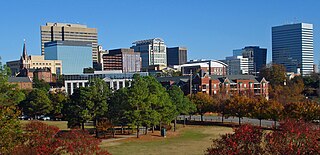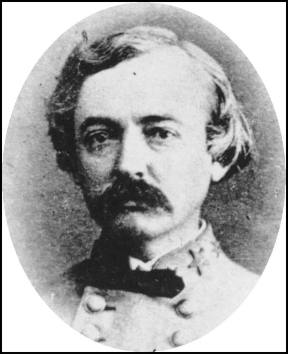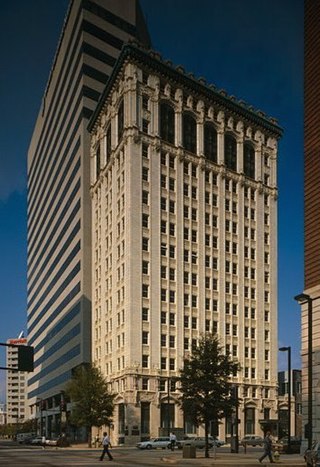
Richland is a city in Benton County, Washington, United States. It is located in southeastern Washington at the confluence of the Yakima and the Columbia Rivers. As of the 2020 census, the city's population was 60,560. Along with the nearby cities of Pasco and Kennewick, Richland is one of the Tri-Cities, and is home to the Hanford nuclear site.

Columbia is the capital city of the U.S. state of South Carolina. With a population of 136,632 at the 2020 census, it is the second-most populous city in South Carolina. The city serves as the county seat of Richland County, and a portion of the city extends into neighboring Lexington County. It is the center of the Columbia Metropolitan Statistical Area, which had a population of 829,470 in 2020 and is the 7th largest urban center in the Deep South and the 72nd-largest metropolitan statistical area in the nation. The name Columbia is a poetic term used for the United States, derived from the name of Christopher Columbus, who explored for the Spanish Crown. Columbia is often abbreviated as Cola, leading to its nickname as "Soda City."

The town of Hillsborough is the county seat of Orange County, North Carolina, United States and is located along the Eno River. The population was 6,087 in 2010, but it grew rapidly to 9,660 by 2020.
Francis Nash was a brigadier general in the Continental Army during the American Revolutionary War. Prior to the war, he was a lawyer, public official, and politician in Hillsborough, North Carolina, and was heavily involved in opposing the Regulator movement, an uprising of settlers in the North Carolina piedmont between 1765 and 1771. Nash was also involved in North Carolina politics, representing Hillsborough on several occasions in the colonial North Carolina General Assembly.

Robert Mills was a South Carolina architect known for designing both the first Washington Monument, located in Baltimore, Maryland, as well as the better known monument to the first president in the nation's capital, Washington, DC. He is sometimes said to be the first native-born American to be professionally trained as an architect. Charles Bulfinch of Boston perhaps has a clearer claim to this honor.

Thomas Lincoln Casey Sr. was a noted American military and civil engineer of the late 19th century. He served as Chief of Engineers for the United States Army Corps of Engineers and oversaw the completion of the Washington Monument. American engineer Richard Weingardt wrote that Casey was the "U.S. Army Corps of Engineers’ most visible and celebrated builder of public buildings, monuments, and other significant works in the latter part of the 19th century."

The South Carolina State House is the building housing the government of the U.S. state of South Carolina, which includes the South Carolina General Assembly and the offices of the Governor and Lieutenant Governor of South Carolina. Located in the capital city of Columbia near the corner of Gervais and Assembly Streets, the building also housed the Supreme Court until 1971.

William Henry Chase Whiting was a United States Army officer who resigned after 16 years of service in the Army Corps of Engineers to serve in the Confederate States Army during the American Civil War. He was wounded at the Second Battle of Fort Fisher by a musket ball to his leg, and died in prison camp on March 10, 1865, of dysentery.
The Hillsborough District Brigade of militia was an administrative division of the North Carolina militia established on May 4, 1776. Brigadier General Thomas Person was the first commander. Companies from the eight regiments of the brigade were engaged in 55 known battles and skirmishes in North Carolina, South Carolina, and Georgia during the American Revolutionary War. It was active until the end of the war.

Samuel Sloan was a Philadelphia-based architect and best-selling author of architecture books in the mid-19th century. He specialized in Italianate villas and country houses, churches, and institutional buildings. His most famous building—the octagonal mansion "Longwood" in Natchez, Mississippi—is unfinished; construction was abandoned during the American Civil War.

The South Carolina Governor's Mansion is a historic U.S. governor's mansion in the Arsenal Hill neighborhood of Columbia, South Carolina and the official residence of the governor of South Carolina. It is a Federal style home influenced by British Colonial plantations. The building has a white stucco exterior and originally served as faculty quarters for the Arsenal Academy, which together with the Citadel Academy in Charleston formed the South Carolina Military Academy. The Arsenal was burned along with the city of Columbia by Sherman's forces in February, 1865; the structure was the only surviving building and became South Carolina's executive mansion in 1868. On June 5, 1970, the building was registered with the U.S. National Register of Historic Places. The mansion is located on a single city block, and is surrounded by magnolia plants, elm and oak trees, and various other plants. It is accessed by a circular driveway around a fountain in front on the residence's main entrance. The building has a flat roof and a large central pavilion around the main entrance. The mansion has 15 rooms. It is located in Columbia Historic District I. The mansion is currently occupied by Governor Henry McMaster and his family.
Kay Patterson is an American politician who was a Democratic member of the South Carolina Senate, representing the 19th District from 1985 to his retirement in 2008. He was previously a member of the South Carolina House of Representatives from 1975 through 1985.

John Rudolph Niernsee was an American architect. He served as the head architect for the Baltimore and Ohio Railroad. Rudolph also largely contributed to the design and construction of the South Carolina State House located in Columbia, South Carolina. Along with his partner, James Crawford Neilson, Rudolph established the standard for professional design and construction of public works projects within Baltimore and across different states in the United States.

Edward Brickell White, also known as E. B. White, was an architect in the United States. He was known for his Gothic Revival architecture and his use of Roman and Greek designs.

William Nichols, Sr. was an English-born architect who emigrated to the United States and became most famous for his early Neoclassical-style buildings in the American South. He designed statehouses for North Carolina, Alabama and Mississippi.

The Palmetto Building, built during 1912–1913, is an early skyscraper in Columbia, South Carolina. It was designed by architect Julius Harder, and Wilson and Sompayrac served as supervising architects. Upon completion it was the tallest building in South Carolina at 215 ft (66 m) and with 15 floors.

Gervais Street Bridge is a historic bridge in South Carolina in the United States and it is listed on the National Register of Historic Places. It is an arch bridge constructed from reinforced concrete. Construction began in 1926 and the bridge was completed in 1928. It was added to the National Register of Historic Places in 1980.

North Carolina Polytechnic Academy, founded as Hillsborough Military Academy and also known as North Carolina Military Academy, was a school in Hillsborough, North Carolina. Col. Charles C. Tew CSA founded Hillsborough Military Academy. He was later killed in action at Battle of Antietam in 1862 on the eve of his promotion to brigadier general. Architect John A. Kay designed the Hillsborough Military Academy barracks building and commandant's house. Edmund Strudwick was the doctor for the Hillsborough Military Academy in the 1860s and cared for soldiers wounded in the Civil War at his home nearby.

Eagle Lodge is a historic Masonic lodge building located at Hillsborough, Orange County, North Carolina. It was built in 1823, and two-story, three bay, square brick building in the Greek Revival style. It has a low hipped roof with heavy box cornice and a one-story pedimented porch with Ionic order columns.

Lyles, Bissett, Carlisle, and Wolff (LBC&W), an architecture firm based in Columbia, South Carolina, was the region's most prominent firm from 1948 until 1975. While the roots of the firm stretch back to 1938, LBC&W was officially incorporated in 1948 as William G. Lyles, Thomas J. Bissett, William A. Carlisle, and Louis M. Wolff. LBC&W's streamlined operational structure, atypically high employment numbers, and varied portfolio contributed to the success of the firm. The firm had satellite offices in Richmond, Virginia; Washington, D.C.; Spartanburg, South Carolina; Raleigh, North Carolina; and Rockville, Maryland. At its height, over 350 architects, engineers, and other staff members were employed by LBC&W. The firm completed over 7,000 projects in its 30-year span, many of which were on the cutting edge of Modern architecture. From Clemson University's library that reflects the influence of Edward Durell Stone's Embassy at New Delhi to the Bankers Trust Tower in downtown Columbia that mimics the Seagram Building by Mies van der Rohe, LBC&W incorporated the methodologies and designs of the great architects of the twentieth century. LBC&W designed some of South Carolina's – and certainly Columbia's – most prominent commercial and private buildings, contributing greatly to the modern built environment of Columbia today.
















